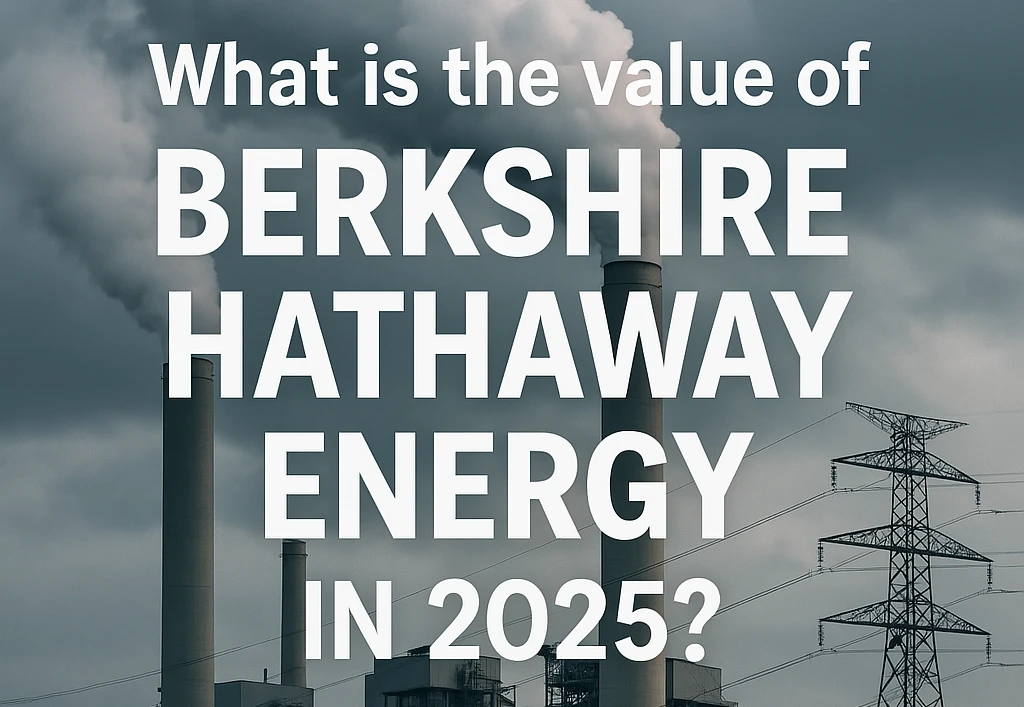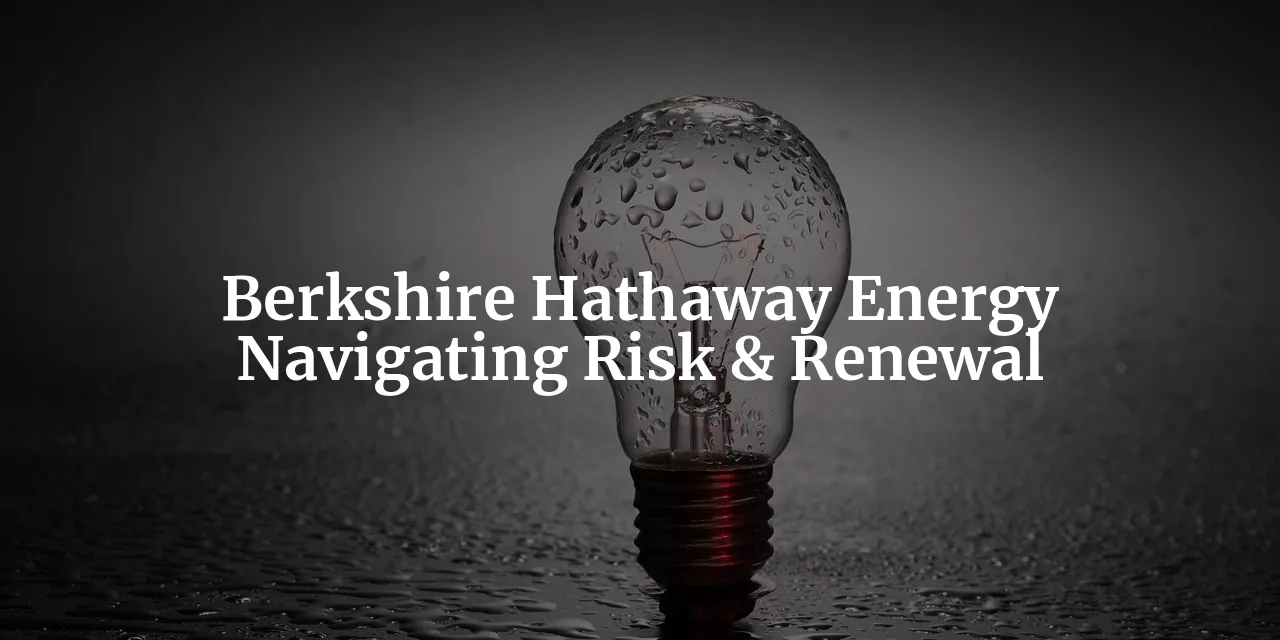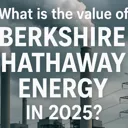Tags: BHE
This fanpage is not officially affiliated with Berkshire Hathaway: Disclaimer
Recently, a user on shrewdm.com 7 posed a compelling question: What is Berkshire Hathaway Energy (BHE) really worth today? Is its value closer to the $87 billion implied by Greg Abel’s 1% stake acquisition in 2022, or to the $49 billion valuation suggested by the Scott family’s 8% stake sale in 2024? That’s a substantial discrepancy—and one that merits closer examination. In this analysis, we’ll explore the valuation in depth, incorporating insights from the legendary Chris Bloomstran of Semper Augustus ↗, whose recent work adds valuable perspective to the discussion.

Introduction
If Warren Buffett is the gold standard of value investing, then trying to pin down the value of Berkshire Hathaway Energy (BHE) is the modern-day gold rush—a quest as thrilling, and confounding, as any Sherlock Holmes mystery. For decades, investors have watched Buffett sniff out bargains with his signature blend of Midwestern charm and razor-sharp negotiation. But when it comes to BHE, even the Oracle of Omaha seems to relish keeping the cards close to his vest.
Since Berkshire’s 2024 buyout of the Scott family’s 8% stake ↗, the conglomerate owns 100% of its quietly massive utility arm—a sprawling, capital-hungry, and litigation-prone empire that stretches from the wind-swept plains of Iowa to the gridlocked real estate markets of London and Los Angeles 15. Unlike the headline-grabbing stakes in Apple or the iconic BNSF railroad, BHE operates in the shadows of the regulated utility world, where earnings are steady but surprises—good and bad—can lurk behind every regulatory filing and wildfire season.
Why does BHE’s valuation matter so much? For Berkshire shareholders, it’s not just about marking up the balance sheet. Utilities were once the “widows and orphans” stocks—synonymous with safety, stability, and dividends 6. Today, they’re at the epicenter of a global transformation: decarbonization, electrification, and the regulatory tug-of-war between innovation and risk. BHE’s journey is a microcosm of this shift, as it navigates the crosscurrents of green energy mandates, wildfire litigation, and the relentless demand for capital.
This article is your guided odyssey through the BHE labyrinth: we’ll explore its assets and subsidiaries, dissect its earnings power, untangle the regulatory web, and confront the landmines of litigation. Along the way, we’ll wrestle with the art (and agony) of valuation—a process that’s as much about judgment as it is about numbers. After all, BHE’s implied value has swung from $87 billion in 2022 to a $49 billion deal price in 2024—so what’s it really worth? 1
Expect a journey that’s thorough, multidimensional, and just a bit irreverent—because if Buffett can drive a hard bargain with the estate of a lifelong friend, so can we with the numbers.
From MidAmerican to BHE: The Empire Buffett Built
The saga of Berkshire Hathaway Energy began in 1999, when Buffett’s Berkshire acquired a controlling stake in the then-obscure MidAmerican Energy Holdings Company for a mere $35 per share 5. What started as a regional utility has since morphed into a global powerhouse—one that now sits at the crossroads of America’s energy future and the world’s real estate ambitions.
Over the past quarter-century, BHE has assembled a dizzying portfolio of assets—from wind farms in Iowa to gas pipelines spanning the Rockies, from the neon-lit casinos of Nevada to the leafy suburbs of London. The company’s major holdings now include 45:
| Subsidiary/Asset | Description |
|---|---|
| MidAmerican Energy Company | Electric and gas utility in Iowa and Illinois |
| PacifiCorp (Pacific Power, Rocky Mountain Power) | Western U.S. electric utility, acquired 2005 |
| NV Energy | Nevada’s dominant electricity and gas provider |
| Northern Powergrid | U.K. electricity distribution |
| BHE Renewables | Wind, solar, geothermal, and hydroelectric generation |
| BHE Pipeline Group | 21,000 miles of U.S. interstate natural gas pipelines |
| Cove Point LNG ↗ | 75% interest in LNG export terminal and storage (Maryland) |
| AltaLink | Major Canadian transmission business (Alberta) |
| HomeServices of America (BHHS) | Largest U.S. residential real estate brokerage/franchise |
| BYD Company | Strategic equity stake in Chinese EV and battery giant |
Today, BHE is the largest U.S. investor-owned utility group with clean power in operation, producing over 34,000 megawatts annually and serving 13 million customers across Iowa, Nevada, Oregon, Washington, Northern California, Utah, Wyoming, Idaho, Alberta, and Great Britain 4. Its energy costs are substantially below the U.S. average, a testament to relentless investment in renewables and infrastructure.
But BHE isn’t just about electrons and pipelines. Its gas pipeline empire—21,000 miles strong—transports roughly 15% of U.S. natural gas consumption. Strategic assets like Cove Point LNG and AltaLink in Canada extend its reach into export markets and cross-border transmission 45. Meanwhile, HomeServices of America has quietly become the nation’s largest residential real estate brokerage, with $4.2 billion in annual revenue and a growing footprint in luxury markets 4.
What sets BHE apart is its “never send profits to Omaha” culture. For 25 years, the company has reinvested every dollar of profit—fueling more than $100 billion in capital expenditures and transforming itself into a renewables juggernaut 4. While competitors pay out dividends and scramble for new capital, BHE’s retained earnings and prudent leverage have enabled it to outspend and outbuild the field.
This relentless growth has unfolded against the backdrop of a regulatory pendulum that swings between freewheeling entrepreneurship and meticulous oversight. In the early days, Edison and Tesla’s utility empires operated in a near-lawless environment 6. Today, BHE’s business is shaped by a patchwork of state commissions and FERC oversight—a regulatory labyrinth that governs rates, investment returns, and environmental mandates.
BHE’s asset growth is no accident. It’s a direct response to macro trends: urbanization, population growth, and the global race to decarbonize. In many ways, BHE is both a 19th-century monopoly—with the scale and stability that implies—and a 21st-century green pioneer, leading the charge into wind, solar, and grid modernization.
From its humble MidAmerican roots to its current status as a diversified energy and real estate colossus, BHE is the empire that Buffett built—one reinvested dollar at a time.
The Utility Business: Predictable, Political, and Perilous
For more than a century, utility companies have been the bedrock of American capitalism—a paradoxical blend of predictability and peril. On the surface, the appeal is obvious: regulated monopolies enjoy stable, recession-resistant cash flows, with state commissions promising a “reasonable” return on investment. In theory, this creates a sleep-well-at-night business: customers can’t easily switch, demand is inelastic, and the government all but guarantees a profit—so long as you play by the rules 6.
But the rules are written in pencil, not ink. The utility sector is a political chessboard, where fortunes rise and fall with the whims of regulators, legislators, and, increasingly, the courts. Berkshire Hathaway Energy (BHE) operates at the heart of this maze, serving over 13 million customers across the fast-growing Western U.S., with distribution assets stretching into Canada and Great Britain 4 ↗. Its competitive edge is real: energy costs are substantially below the national average, and BHE’s territories—from Iowa to Nevada to Oregon—are expanding faster than the U.S. population 4. Meanwhile, BHE’s renewables-heavy portfolio—with half its generating capacity from wind and solar—positions it ahead of the curve as the country pivots away from coal and gas 4.
Yet, the regulatory landscape is complex and ever-shifting. State public service commissions set rates and demand universal service, while the Federal Energy Regulatory Commission (FERC) oversees interstate transmission, pipeline approvals, and power purchase agreements (PPAs) that can lock in prices for decades 6. Layer on top the patchwork of decarbonization mandates, federal incentives for clean energy, and the logistical bottlenecks of building new transmission lines, and it’s clear that navigating this environment requires both patience and political savvy 7.
BHE’s reinvestment strategy sets it apart. Unlike its peers—who typically pay out 75% of profits as dividends and must regularly tap capital markets for growth—BHE retains all earnings and layers on debt to fund its ambitious capital program 4. Over the past two decades, it has plowed more than $100 billion into capital expenditures, dwarfing depreciation and enabling rapid asset growth without diluting shareholders or raising equity 4. This is classic Buffett: compounding capital internally, sidestepping Wall Street’s short-termism, and building an empire brick by brick.
But even the best-run utility can’t escape the industry’s headwinds. Rising interest rates have driven up the cost of capital and compressed valuation multiples, while transmission buildout delays—caused by permitting snarls and NIMBY opposition—threaten to bottleneck the transition to renewables 7. There’s also the ever-present threat of regulatory overreach: a sudden policy shift toward public power, or aggressive rate cuts, can turn yesterday’s safe haven into tomorrow’s cautionary tale 1.
Still, the tailwinds are powerful. The electrification of everything—from cars to data centers—has turbocharged demand forecasts. AI, cryptocurrency mining, and the reshoring of manufacturing are driving electricity consumption higher, while the multi-decade transition from coal to renewables is creating enormous investment opportunities 7. BHE is already the largest investor-owned utility group with clean power in operation, and its $18 billion grid modernization program puts it at the forefront of the sector’s transformation 4.
History reminds us that politics and utilities are inseparable. The New Deal’s public power movement reshaped the industry in the 1930s, just as today’s bipartisan push for grid modernization and decarbonization is rewriting the playbook ↗. For BHE—and its shareholders—the challenge is to harness the sector’s predictability while surviving its political and regulatory perils.
Wildfire Litigation and Other Landmines
If the utility business is a fortress, then wildfire litigation is the battering ram at the gate. Nowhere is this more evident than in BHE’s PacifiCorp subsidiary, which has become ground zero for the sector’s new existential risk: catastrophic liability from climate-driven disasters. The numbers are staggering: PacifiCorp has reserved nearly $3 billion for wildfire losses, faces $1.45 billion in unpaid claims, and is staring down a class action in Oregon seeking a jaw-dropping $46 billion for non-economic losses, punitive damages, and attorney’s fees 2. For context, PacifiCorp’s equity is just $9 billion—making the potential liabilities not just material, but “insane,” as one analyst put it 2.
The legal backdrop is Kafkaesque. In the September 2020 fires that devastated Oregon and Northern California, PacifiCorp’s equipment was not found to have started any fires. The company kept the power flowing during the crisis to support hospitals and first responders, following industry protocol 2. Yet, in today’s legal environment, utilities can be found liable for damages even when their equipment isn’t the ignition source—especially if plaintiffs’ attorneys can argue that power lines should have been de-energized preemptively. The complaints seek $3 billion in economic damages, with insurance covering just $500 million, and the specter of treble damages or punitive awards looms large 2.
This isn’t just a PacifiCorp or BHE problem—it’s a systemic risk for every Western utility. Investors have taken notice, demanding discounts for these “tail risks.” When Berkshire acquired the final 8% of BHE from the heirs of Walter Scott, the purchase price reflected a significant discount, in part because of wildfire liability exposure 1. As Warren Buffett himself admitted, “I did not anticipate or even consider the adverse developments in regulatory returns and… made a costly mistake in not doing so” 1. The market is now pricing in the possibility that a single event—however improbable—could wipe out years of profits, or worse.
BHE’s approach is aggressive legal defense and a belief that losses will be “manageable” relative to its capital base 2. Importantly, Berkshire does not guarantee the debts or liabilities of its utility subsidiaries—a crucial firewall that limits the parent’s exposure 2. It’s a reminder of an old Wall Street adage: “You can’t lose more than you put in, but you sure can lose it all.” The risk is not just financial, but existential: the 2001 California energy crisis and PG&E’s bankruptcy showed that even regulated monopolies can be brought to their knees by a combination of bad luck, bad weather, and bad policy.
And wildfires aren’t the only landmine. BHE’s Home Services of America—the nation’s largest residential real estate brokerage—recently paid $250 million to settle antitrust lawsuits over commission-sharing practices 2. While the settlement was a fraction of the potential exposure, it’s a stark reminder that even the “boring” parts of the business can harbor hidden risks.
For Berkshire Hathaway shareholders, the lesson is clear: utilities are not risk-free annuities. They are living, breathing organisms, subject to the laws of physics, politics, and human error. The challenge—and the opportunity—is to understand these risks, price them appropriately, and trust in the fortress-like balance sheet and culture of discipline that has defined the Berkshire way.
The Art (and Agony) of Valuing BHE
Valuing Berkshire Hathaway Energy (BHE) is not for the faint of heart ↗. What might look like a simple exercise—multiplying earnings by an industry multiple or book value by a peer ratio—quickly becomes a labyrinth of contradictory signals, unique risks, and Buffettian negotiation tactics. For Berkshire Hathaway shareholders, the recent journey to 100% ownership of BHE is a masterclass in both the art and agony of corporate valuation.
Consider the valuation puzzle laid bare by two recent transactions. In 2022, Berkshire paid $1,175 per share to Greg Abel for a 1% stake, implying a company value of $87 billion1. Fast-forward to 2024: the heirs of Walter Scott, Buffett’s longtime friend and boardroom confidant, sold their 8% stake for just $650 per share—a mere $49 billion valuation1. That’s a 45% haircut in less than two years, and the sort of discount that only the most hard-nosed of negotiators (Buffett himself, in this case) could extract, even from an old friend’s estate.
What’s behind this dramatic spread? Book value—BHE’s shareholder equity—is about $50 billion14. Some analysts, like Chris Bloomstran of Semper Augustus, peg BHE’s equity value closer to $90 billion14. Meanwhile, industry peers such as Duke Energy and American Electric Power trade at roughly 2x book value; Southern Company and NextEra Energy fetch about 3x book1. The market, in other words, often values large utilities at a premium to book, reflecting their regulated earnings and steady dividends.
Let’s put these numbers in context:
| Company | Book Value ($B) | Market Cap ($B) | Price/Book | 2024E Net Income ($B) | P/E Multiple | Notes |
|---|---|---|---|---|---|---|
| BHE (Scott Deal) | ~$50 | $49 | ~1.0x | $4.3–4.8 | 10–11x | 2024, includes wildfire accruals |
| BHE (Abel Deal/Analyst) | ~$50 | $87–90 | ~1.8x | $4.3–4.8 | 18–21x | 2022, pre-wildfire discount |
| Duke Energy | ~$56 | ~$110 | ~2.0x | ~$4.2 | ~26x | Peer, regulated utility |
| American Electric | ~$27 | ~$55 | ~2.0x | ~$2.6 | ~21x | Peer, regulated utility |
| Southern Company | ~$33 | ~$100 | ~3.0x | ~$4.0 | ~25x | Peer, regulated utility |
| NextEra Energy | ~$44 | ~$135 | ~3.0x | ~$5.0 | ~27x | Peer, renewables leader |
Why the discount for BHE? The answer lies in the shadow of wildfire litigation. BHE’s PacifiCorp unit faces potentially massive liabilities from the catastrophic 2020 Oregon and Northern California wildfires. The company has already reserved nearly $3 billion for wildfire losses and warned of “significant additional” exposure1. This cloud, combined with regulatory uncertainty and a changing political landscape for utilities, has spooked even the most stalwart investors.
Yet, BHE’s 2024 earnings power is formidable ↗. After adjusting for wildfire accruals and the windfall of federal tax credits for renewables, BHE was able to generate $4.3–$4.8 billion in net income for Berkshire 4. The company’s tax rate is a remarkable negative 77%, thanks to roughly $2 billion in production and investment tax credits and accelerated depreciation from its vast wind and solar portfolio 4. This is a double-edged sword: while tax incentives juice near-term returns, they also make year-to-year earnings volatile and harder to compare with peers.
Then there’s the BYD stake—BHE’s investment in the Chinese electric vehicle and battery giant. At its 2021 peak, this holding was worth $7.7 billion; by year-end 2024, after Berkshire trimmed its position, it had fallen to $775 million4. Whether analysts include or exclude BYD can swing BHE’s value by billions, further muddying the waters.
So, what’s the “right” multiple? On a sum-of-the-parts basis, BHE trades at 16–17x earnings (net of BYD), in line with the lower end of utility peers 4. But a litigation-prone, low-growth utility might deserve just 12–14x—implying a value closer to $50–60 billion if wildfire liabilities linger 4. The Buffett discount is real: the Scott family, despite decades of loyalty, received no sentimental premium. As one observer put it, “Even the estate of a longtime friend did not seem to receive a break from Buffett” 1.
Ultimately, BHE’s true value is a moving target—buffeted by litigation outcomes, regulatory returns, interest rates, and the pace of renewables adoption. It is a far cry from the “widows and orphans” simplicity of yesteryear’s utility investments. As Warren Buffett himself admitted, “I did not anticipate or even consider the adverse developments in regulatory returns and, along with Berkshire’s two partners at BHE, I made a costly mistake in not doing so” 1.
For Berkshire Hathaway shareholders, this is the new reality: BHE is a utility colossus, but one whose value is as dynamic—and as fraught with uncertainty—as the energy transition itself. You may need to decide for yourself where in-between the band of $49 to $87 billion you want to value the subsidiary.

Conclusion: BHE’s Value—A Moving Target in a Changing World
From its modest origins as MidAmerican Energy in 1999 to its current stature as a sprawling $50–90 billion energy titan wholly owned by Berkshire Hathaway, Berkshire Hathaway Energy (BHE) embodies a remarkable journey of transformation and growth 5. This odyssey reflects not only the vision and discipline of Warren Buffett’s capital allocation but also the evolving complexities of the modern utility landscape.
Ironically, the most “boring” business in Berkshire’s empire—the regulated utility—may be the hardest to value. Beneath the veneer of steady cash flows and regulated returns lies a world shaped by regulatory roulette, climate-driven wildfire litigation, and the relentless push toward decarbonization. These forces inject volatility and uncertainty into what was once considered a predictable, low-risk sector. BHE’s recent valuation swings—from an $87 billion estimate in 2022 to a $49 billion deal price in 2024—underscore how swiftly the ground can shift beneath even the most stable utility 1.
For shareholders, BHE’s value is far more than a static number on the balance sheet. It is a bet on Buffett’s unparalleled ability to allocate capital wisely, navigate regulatory labyrinths, and steer through political storms. The company’s unique reinvestment model—retaining all earnings to fuel capital expenditures rather than paying dividends—provides a competitive advantage that fuels growth but also obscures its true earning power relative to dividend-paying peers 4. This internal compounding, combined with prudent leverage, positions BHE to capitalize on the accelerating trends of electrification, population growth, and grid modernization that are reshaping the energy sector 7.
Looking ahead, BHE’s long-term worth is poised to rise—assuming it can weather the inevitable legal and regulatory earthquakes that come with operating at the intersection of infrastructure and politics. The Western U.S. and Canadian territories BHE serves are growing faster than the national average, while its $18 billion grid modernization program and nearly $40 billion invested in renewables place it at the forefront of the clean energy transition4. Yet, as history teaches us—from the railroads and telegraphs of the 19th century to today’s utilities—these assets are not just infrastructure; they are political footballs, valued as much for their resilience and adaptability as for their earnings.
In this light, BHE’s valuation is a moving target, shaped by the ebb and flow of regulatory decisions, litigation outcomes, interest rates, and technological innovation. The wildfire liabilities haunting PacifiCorp serve as a stark reminder that even the most fortress-like businesses can face existential threats2. But if there is one constant, it is Buffett’s negotiating prowess and discipline. The fact that even the Scott family—longtime friends and partners—received no sentimental premium in their stake sale speaks volumes about the rigor with which BHE’s value is determined 1.
For Berkshire Hathaway shareholders, this should offer a measure of comfort. While the next wildfire, rate case, or regulatory revolution may test the company’s mettle, the fortress that Buffett built—brick by reinvested brick—remains formidable. BHE is not just a utility; it is a modern utility odyssey—a complex, evolving enterprise that mirrors the challenges and opportunities of the energy transition itself.
In the end, owning BHE means owning a stake in the future of energy infrastructure, with all its risks and rewards. It is a journey best undertaken with patience, insight, and trust in the stewardship that has guided Berkshire Hathaway for decades.
Annex: Chris Bloomstran's table for Berkshire Hathway's valuation 2025
Here's a digitized version of Chris Bloomstran's valuation metric provided in his annual letter 2024 4:
| Item | Amount |
|---|---|
| Revenues Total | $26.1 B |
| Energy Operating Revenue | $21.4 B |
| Real Estate Operating Revenue | $4.2 B |
| Other Income (Loss) | $0.45 B |
| Pre-tax Income (Excludes gain/loss BYD and invest.) | $2.7 B |
| Income Tax Expense (Benefit) | -$2.0 B |
| Net Income (GAAP) | $4.7 B |
| Non-Controlling Interests of BHE Subs | $0.287 B |
| Net Earnings Attributable to BHE | $4.6 B |
| Net Earnings Attributable to BRK | $4.3 B |
| Net Earnings Attributable to BRK (Adjusted for cash taxes) | $4.8 B |
| Net Earnings Attributable to BHE (Adjusted for cash taxes) | $5.2 B |
| Net Earnings BHE Adjust PacifiCorp Wildfires 0.4B pretax | $5.364 B |
| Net Earnings BRK Adjust PacifiCorp Wildfires | $4.88 B |
| Reported Tax Rate (Derived MD&A - not cash adjusted) | -76.5% |
| Cash Tax Rate (Deferred taxes exceed reported tax) | -107.0% |
| Goodwill (From BHE 10-Q, 10-K) | $11.5 B |
| Deferred Tax Liability (Including investments) | $12.4 B |
| Amortization of Intangibles | $0.257 B |
| Depreciation | $3.9 B |
| Capital Expenditures | $8.8 B |
| BYD and Other NDC Trust Stocks; BYD $0.775B | $1.725 B |
| BHE Equity (Including BYD, NDCs, Rabbi and Non-Control) | $51.9 B |
| BHE Non-Controlling Int (75% Cove, 50% Iroquois and ETT) | $1.3 B |
| BHE Equity Net of BHE Non-Controlling Interests | $50.6 B |
| BHE Equity Net of NCI and Net of BYD/Investments | $48.9 B |
| BRK Non-Controlling Interests (0 in 2024) | $0 B |
| BRK Equity in BHE (100% at 9/30/24 net of BHE NCIs) | $50.6 B |
| BHE/BRK Equity (Excluding $3.5 B Investments Net of DTL) | $48.8 B |
| Total Assets (Including BYD and Investments) | $141.8 B |
| Debt | $57.3 B |
| Cash | $2.9 B |
| Interest | $2.722 B |
| After-Tax Interest | $2.150 B |
| ROE GAAP w/ % DTL (includes $9.7 billion goodwill) | 9.3% |
| ROE (Adjusted for cash taxes) | 10.3% |
| ROE Net of Cash | 7.1% |
| Estimated BHE/BRK Value With BYD Net of Tax and NCI | $86–91 B |
| Implied P/E | 16–17 |
References
-
Berkshire Hathaway Gets a Great Price in Buying Stake in Its Own Utility Unit - www.barrons.com ↩↩↩↩↩↩↩↩↩↩↩↩↩↩↩
-
2024 SAI Letter: Won't Get Fooled Again: Three Ways You Can Go Broke; Bogleheads; And – Berkshire Hathaway: Getting In Tune - www.semperaugustus.com ↩↩↩↩↩↩↩↩
-
Annual Report 2024 - Results of Operations - www.berkshirehathaway.com ↩
-
2024 SAI Letter: Won't Get Fooled Again: Three Ways You Can Go Broke; Bogleheads; And – Berkshire Hathaway: Getting In Tune (BHE Valuation Part) - www.semperaugustus.com ↩↩↩↩↩↩↩↩↩↩↩↩↩↩↩↩↩↩↩↩↩
-
Berkshire Hathaway Energy - Wikipedia - en.wikipedia.org ↩↩↩↩↩
-
How Strongly Do Regulations Impact the Utilities Sector? - www.investopedia.com ↩↩↩↩
-
9 US electric power sector issues to watch in 2025 - www.utilitydive.com ↩↩↩↩↩
-
Post #14336 by mungofitch on the Berkshire Hathaway board - www.shrewdm.com ↩












